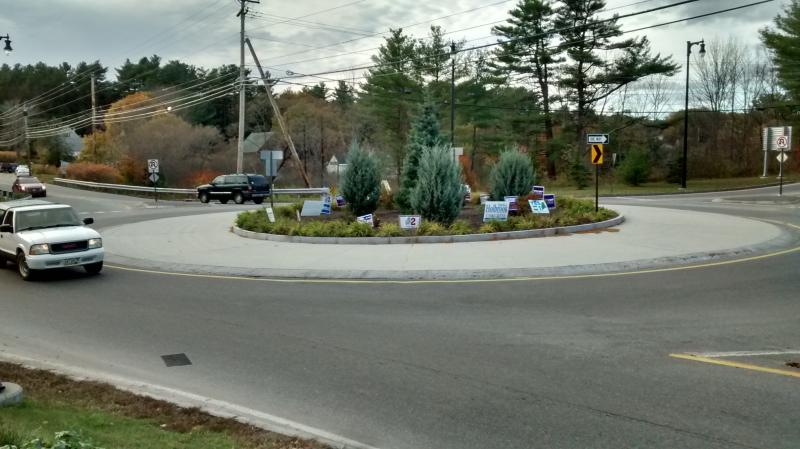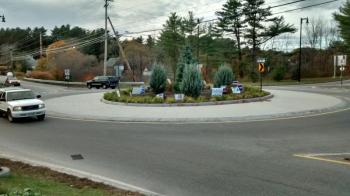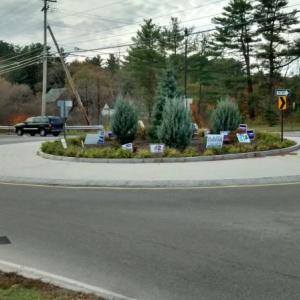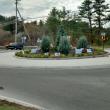Roundabout vote driving people to polls
 Maine Department of Transportation officials describe the proposed Boothbay roundabout as similar in size to one in Bath. MORGAN CALLAN ROGERS/Boothbay Register
Maine Department of Transportation officials describe the proposed Boothbay roundabout as similar in size to one in Bath. MORGAN CALLAN ROGERS/Boothbay Register
 Maine Department of Transportation officials describe the proposed Boothbay roundabout as similar in size to one in Bath. MORGAN CALLAN ROGERS/Boothbay Register
Maine Department of Transportation officials describe the proposed Boothbay roundabout as similar in size to one in Bath. MORGAN CALLAN ROGERS/Boothbay Register
By Election Day, nearly one-third of Boothbay voters will have already cast ballots, according to Town Clerk Lynn Maloney. Most years, it’s the presidential election driving people to the polls. But this year, three local referendum questions — all concerning the proposed roundabout — will likely garner a voter turnout close to 90 percent, according to town officials.
This will be the second time in three years Boothbay residents will vote on a Route 27 traffic redevelopment plan. In 2013, voters rejected constructing a roundabout around the Civil War Monument, 625 to 444. In February, the roundabout re-emerged as a possible solution to Route 27 traffic congestion.
For years, the Maine Department of Transportation has rated the Corey Lane intersection as an “F,” due to an average 60 second per vehicle wait time during peak travel times. The combination of high volume of traffic navigating the double stop signs on Corey Lane and Back River Road is the main reason for the problem, according to MDOT officials.
“I’ve fielded complaints down there for years,” said Steve Landry, who has worked for the DOT for 30 years with the last four as state traffic engineer. “This is the third time the department has taken a look at it. People have a tough time getting through that intersection because of the four-way stop.”
Route 27 traffic concerns intensified last November and December with Coastal Maine Botanical Gardens’ inaugural Gardens Aglow. The event drew 36,000 visitors, which was about 10 times greater than officials expected. This led Knickerbocker Group and local businessman Paul Coulombe to re-examine Route 27 traffic flow and safety.
Coulombe, who owns the Boothbay Harbor Country Club and other properties near the Boothbay Common, has touted the roundabout during a series of community forums and paid political advertisements. He describes the proposal as vital to the community’s long term future.
“I think it’s important to the peninsula. It benefits everyone whether it’s year-round residents, summer people or tourists. Safety is the prime issue, but it will also do a lot for economic development which this region desperately needs,” Coulombe said.
Roundabout opponents are led by a citizens group formed in July by Sunny Acres Lane resident Fred Kaplan. The group, Citizens Against the Roundabout, has consistently challenged MDOT consultant Mark Lenters’ and Coulombe’s conclusions about the proposal.
“The roundabout works against us. It undermines the distinctiveness and uniqueness of our being a historic New England town,” Kaplan said. “Putting in a roundabout makes us look like everywhere else.”
The committee has about 36 active members, according to Kaplan. The group doesn’t believe Corey Lane presents a major traffic flow or safety problem. Members believe the Route 27 Traffic Study’s only benefactor is Coulombe’s Boothbay Village Square. The proposed development would be located on Coulombe’s properties near the Boothbay Common. The BVS would include eight to 10 businesses.
Coulombe envisions the Village providing services not readily available in Boothbay or Boothbay Harbor. His preliminary idea is for a design consistent with the town’s historic look.
Coulombe, a Lewiston native, moved to Southport in 2008 as a seasonal resident. In 2012, he sold White Rock Distilleries and retired. Later that year, he became a year round resident. Coulumbe, 66, has vacationed in the Boothbay Region since childhood.
“I love it here! And I don’t want to change the community,” he said. “Everything I’ve done is to enhance what already makes this such a great place to live.”
He also has made large contributions to several nonprofits such as Boothbay Harbor Opera House, YMCA, Boothbay Harbor Memorial Library, and local educational programs. His and wife Giselaine’s contributions have saved such historic landmarks as Cuckolds Lighthouse and Gus Pratt’s General Store in Southport.
“I’m motivated to improve the community. I’m a philanthropist,” he said. “We’ve invested tens of millions of dollars into the community which we will never see a return of our investment in dollars. We did it for a more important reason which is making this a better place for everyone.”
The Boothbay Village Square concept came after discussions about the Route 27 Traffic Redevelopment Traffic Study completed in April. Coulombe believes a better traffic plan will entice more tourists and full-time businesses to the region.
“Once you bring (tourists) here they want amenities. That’s how the Village Square plan came about,” Coulombe said.
His plan is to sell, rent or lease buildings to new businesses. Coulombe expects the project to provide 50 jobs and add another $100,000 in property taxes. He doesn’t believe the roundabout would have a significant impact on his proposed development or his golf course. Coulombe said his past investments have all been geared toward philanthropy, not business.
The Coulombes purchased the country club for $1.4 million in 2013. They are in the midst of the second phase of a $30-plus million renovation. He said his business investment and community contributions have all come out of a sense of philanthropy. During a land swap negotiation with Boothbay Region Ambulance Service, the Coulombes made another philanthropic donation.
The couple paid $1.6 million for a new ambulance service headquarters twice the current one’s size. The deal is separate and not impacted by the November vote. The new headquarters is currently under construction with an expected February 2017 completion date.
Citizens Against the Roundabout believes Coulombe’s interest in the roundabout is more geared to his role as a developer, not philanthropist. Members believe he has been the project’s focal point from the beginning. During the town-sponsored informational hearings, opponents complained about the lack of community involvement in drafting the plan. They also believe Coulombe used his influence as a major contributor to the Maine Republican Party and his friendship with Gov. Paul LePage to move the project forward.
“Something that hasn’t been talked about is Mr. Coulombe’s relationship with the governor. He is the single largest contributor to the Maine GOP,” Kaplan said.
In December 2015, Coulombe contributed $60,000 to the House Republican Majority Fund created to elect GOP candidates to the Maine Legislature. He was named as one of the top three contributors to the fund, which paid for a newspaper insert placed in several newspapers, including the Boothbay Register, last week.
LePage, 68, and Coulombe are both businessmen and grew up in Lewiston. LePage owns a seasonal home in Boothbay and attended the May ribbon-cutting ceremony for the golf course’s new clubhouse.
Coulombe said his ties to the Republican Party have nothing to do with his proposal. “They are using false statements to defeat this project because there is no logical reason to oppose this,” he said. “They are trying to scare people because they don’t have the facts on their side.”
Coulombe denied seeking preferential treatment from the MDOT or governor’s office.
“Absolutely not. I haven’t spoken to him (LePage) or any other elected official about this,” he said. “The DOT is an independent agency and is immune from political pressure as the staff are not political appointees.”
State Representative Stephanie Hawke (R-Boothbay Harbor) said Coulombe never requested her assistance in dealing with MDOT. She also said he didn’t make an individual contribution to her campaign.
The committee became suspicious of Lenters’ Route 27 traffic study after learning Coulombe paid for his services. The town hired Ty Lin International of Falmouth to perform a peer review of the study. Kaplan questioned the authenticity of the report since the developer paid for the report. The CAR preferred that a coalition of town members review possible alternatives.
“Their attitude was take it or leave it,” Kaplan said. “We aren’t against change, but it has to be the right change. The question needs to be asked why this specific proposal. The answer is it serves the interests of PGC5 (Coulombe),” Kaplan said.
Town Manager Dan Bryer contends the community has had plenty of involvement with the proposal. The town has sponsored six informational and two public hearings. Coulombe has held two “Lunch and Learn” sessions about the roundabout and one informational session about the Boothbay Village Square proposal.
Bryer also described the current proposal as similar to one in 2002 which was paid for by the state. The current proposal was also changed after an engineer met with property owners along Corey Lane, Back River Road and Route 27 about concerns.
“There has been plenty of involvement,” Bryer said. “During one of the sessions, Back River Road residents complained about losing direct access to the post office. So Steve Sawyer (the engineer) met with them and changed the plan to allow access to the post office for Back River Road residents without using the roundabout.”
During an Oct. 4 “Lunch and Learn” session, Knickerbocker Group Project Manager Danielle Betts explained that the DOT that recommended the proposed roundabout site, not Coulombe.
The current site is based on its proximity to Corey Lane and the readily available amount of town-owned property, according to Betts.
“(DOT) said it made the most sense,” she said.
Landry explained why the developer and not the state paid for Lenters’ study. “It wasn’t a state project,” he said. “So we recommended him because he’s been used on several transportation and roundabout projects around the state.”
According to Landry, the state won’t make a financial investment until Boothbay voters approve a business partnership initiative agreement. The program is a joint-venture between the state, municipality and private entity.
The proposed Route 27 Redevelopment Project has a $3.3 million cost. The state would pledge $1million, the maximum allowed by law. Boothbay and Coulombe would each finance $1.15 million. Boothbay would pay its share through a 20-year bond financed through tax increment finance district funds. In 2014, the town created the TIF which captures increased valuation on improvements to businesses located in the district.
According to Bryer, the district generates plenty of revenue to fund the town’s share. He estimates annual bond payments would cost $67,000 to $72,000. The district captures over $100,000 annually. The TIF district includes the area around Boothbay Common, the municipal building, Boothbay Harbor Country Club and runs along Route 27 to the industrial park. Once the country club’s phase 2 expansion project is done, Bryer said more TIF revenue would follow.
So far, the country club expansion and other Coulombe properties account for all the TIF revenue, according to Bryer. In his advertisements, Coulombe has said the project won’t spend any local taxpayer funds. Roundabout opponents disagree.
“The phrase he uses is free money which is misleading, deceitful and dishonest,” Kaplan said. “People who pay property taxes don’t receive special benefit from them because it’s public money.”
Kaplan prefers using TIF funds for providing water and sewer to the industrial park. Coulombe agrees that would be a good use of TIF monies. But municipal officials say water and sewer for the industrial park is several years away.
“It’s about an $8 million cost and the TIF might contribute about a quarter of the cost. So the rest would come from the taxpayers, and we can’t afford that right now,” Bryer said.
Coulombe also touts the Route 27 Redevelopment Plan’s conclusion that Corey Lane is hazardous and a roundabout would make it safer. In June, the selectmen hired a Falmouth consultant, Ty Lin, International, to conduct a peer review of the Route 27 Traffic Study. Director of Northeast Traffic Engineer Tom Errico delivered his assessment of Lenters’ work during the July 28 informational meeting. He concluded it was a “comprehensive study.” He also agreed that roundabouts generally improve traffic flow and increase safety, but he disagreed that Corey Lane was a proven safety hazard.
“There is just not the data available to support that,” he said.
The CAR believes any problems associated with traffic at Corey Lane are minor. If safety was a significant factor then it would be a state project like the one in Blue Hill, according to committee members.
“Blue Hill was a safety hazard which is why the state became involved. That conclusion hasn’t been reached here,” Kaplan said. “It’s just a few fender benders, and if people have to wait a few extra minutes, it’s still not worth changing the town’s historic character.”
So far, the only town expenses regarding the roundabout are minimal. The town has paid Ty Lin $1,500 and Boothbay Region Cable Television $6,700 to produce a 12-minute informational video. The video featured interviews with Landry and two Blue Hill town officials. Blue Hill Selectman James Schatz explained “at first residents were against the roundabout, but now, everybody loves it.”
Supporters believe a roundabout would inject life into an aging community. Lincoln County is the oldest county in the oldest state by median age, according to U.S. Census data. The school system has seen a 32.5 percent reduction in enrollment in the past two decades, according to Coulombe. He sees the roundabout as boosting the business climate, giving younger people a reason to live here.
“We’re older than Miami Beach and Arizona. Something needs to be done about this. There is a correlation between roundabouts and economic development. Young people don’t stay or move here. So something needs to be done,” Coulombe said.
A “Yes” vote is required for Articles 2, 3 and 4 for roundabout approval. Article 2 requests approval to pay $1.15 million in general obligation bonds to pay the town’s share of the project. Article 3 requests approval to enter into a business partnership initiative with the DOT and Coulumbe. Article 4 requests approval to include town-owned properties in the TIF district, allowing roundabout construction.
A “No” vote on Article 2, 3, or 4 defeats the entire proposal. Whether to build the roundabout isn’t the only controversy about the issue. The three articles’ wording also proved controversial. East Boothbay resident Marcia Soler asked during the September informational hearing why none of the three articles included the word “roundabout.”
“It’s referred to as street improvements or other improvements. I asked three months ago about the wording, and was told it was premature to discuss the language. But roundabout is what people know, and it should’ve been included,” said Soler.
Bryer explained the wording was taken directly from the 14-year-old MDOT study.
“The verbiage was taken from the 2002 report which didn’t mention a roundabout, but I think everybody knows the three questions are all about the roundabout,” he said.
If the roundabout is approved, construction would begin in January on the Corey Lane redevelopment. The project would stop in May and resume in October. The project would be completed in May 2018. If the roundabout is defeated, Boothbay and MDOT officials say there is no Plan B.
“As far as the state is concerned if it’s defeated it’s over. We won’t proceed without the town,” Landry said.
Bryer said without state funding the town couldn’t afford the project without another partner.
Event Date
Address
United States



























